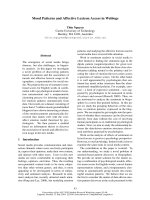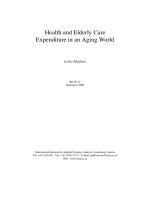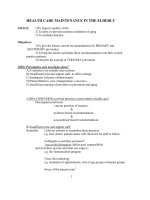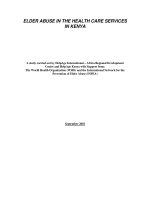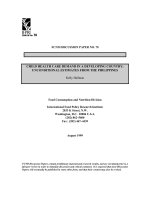Health Insurance And Health Care Access In China
Bạn đang xem bản rút gọn của tài liệu. Xem và tải ngay bản đầy đủ của tài liệu tại đây (328.08 KB, 62 trang )
HEALTH INSURANCE AND HEALTH CARE ACCESS IN CHINA
A Thesis
submitted to the
Graduate School of Arts & Sciences
at Georgetown University
in partial fulfillment of the requirements for the
degree of
Master of Public Policy
in the Georgetown Public Policy Institute
By
Verinda Jean Esther Fike, B.A.
Washington, DC
April 14, 2008
HEALTH INSURANCE AND HEALTH CARE ACCESS IN CHINA
Verinda Jean Esther Fike, B.A.
Thesis Advisor: Michael Clemens, Ph.D.
ABSTRACT
The Chinese government has made recent efforts to expand health insurance to
rural areas that have been primarily dependent upon private health care providers.
Because private providers do not accept insurance, the insurance scheme may cause
patients to shift usage from private to public providers, thus not necessarily resulting in
an overall expansion of health care delivery. This study uses a 2001 survey of 3,600
households in three Chinese provinces to analyze whether health insurance is actually
expanding overall service delivery or is simply switching patients from private to
public provider utilization. By statistically comparing the provider choices of
households with health insurance to those of uninsured households, this study finds
evidence that health insurance expands overall health care utilization in China. The
findings relate only to service utilization and do not address health outcomes.
ii
TABLE OF CONTENTS
INTRODUCTION....................................................................................................... 1
LITERATURE REVIEW ............................................................................................ 4
Historical Background of Health Care Policy in China.................... 4
Rural vs. Urban Health Care ........................................................... 6
Health Insurance............................................................................. 8
The Quality of Private Health Care in China ................................. 12
CONCEPTUAL MODEL.......................................................................................... 13
DATA DESCRIPTION ............................................................................................. 16
ANALYSIS PLAN.................................................................................................... 19
Dependent Variables..................................................................... 19
Independent Variables .................................................................. 22
Interaction Terms.......................................................................... 26
Discussion .................................................................................... 28
DESCRIPTIVE STATISTICS................................................................................... 31
RESULTS ................................................................................................................. 33
DISCUSSION ........................................................................................................... 42
Interactions................................................................................... 46
Patient preferences: Demand vs. Supply ....................................... 51
CONCLUSION ......................................................................................................... 56
REFERENCES.......................................................................................................... 58
iii
INTRODUCTION
China is facing a health care crisis. While total health care spending in China is
increasing, the government’s share of this total spending has shrunk by more than half
since 1980. This decrease in public health financing has been devastating for rural
households where more than 90% of health care spending is now out-of-pocket.
Although 70% of the population lives in rural areas, public health expenditures in these
areas constitutes only 30% of the national total (Lindelow and Wagstaff, 2003). In
some parts of China, more than 60% of those in dire poverty have been driven there by
these huge out-of-pocket medical expenses (Liu et al., 2003).
The disparity between basic health conditions in urban and rural areas of China
is enormous. In 1999, infant mortality was 37 per 1,000 live births in rural areas, as
compared with 11 per 1,000 in urban areas (Blumenthal and Hsaio, 2006). Perhaps
most shocking is that in some poor rural areas, infant mortality has recently increased.
While broad outcomes of this kind depend on much more than health care provision,
these numbers nevertheless suggest that access to quality medical care for rural
residents remains limited and deficient.
In an effort to make health care more available at lower cost, the Chinese
government in March of 2007 announced plans to expand its new cooperative health
care system to cover all rural counties by 2010 (Xinhua, 2007). The expansion of the
program is expected to cost US$1.3 billion this year and US$750 million for each
1
subsequent year. This program will allow rural residents to use a joint fund to pay for
visits in public facilities, but the fund will cover only 40-60% of medical bills. The
joint fund will not be accepted at private health care facilities.
New Chinese health care policies generally fail to recognize the vast number of
private health care facilities serving both rural and urban areas. Private health care
facilities are often more accessible and less costly than public facilities (Liu et al.,
2006). Even if a particular treatment is more affordable at a public facility, the cost
and hassle of transportation to a public provider that is farther away than a private
facility may outweigh the advantage of having insurance. However, urban and rural
residents may experience this difficulty differently as urban residents have greater
access to public facilities.
Previous research suggests that the quality of care in private facilities is better,
worse, or the same as public facilities (Meng et al., 2000; Lim et al., 2002). The rising
incomes of rural households may therefore influence households with health insurance
to seek care at public or private facilities, depending on whether they believe one to
have superior care over the other. For more serious illnesses, however, households
may choose public providers which are generally better equipped to handle these
illnesses.
Although some policymakers believe that expanding health insurance coverage
for rural households is considered effective in making health care more affordable and
thereby expanding overall coverage, the results of any such effort depend crucially on
patients’ decisions to utilize facilities where they are covered (public) versus those
2
where they are not (private). This paper seeks to understand whether health insurance
is expanding overall coverage or whether it is simply moving people from private
health care provision to public provision. Using data from a 2001 household survey of
3,600 households in three provinces in China, this study sets out to answer these
questions. This study finds that households with health insurance in large measure
choose public providers. This outcome is greater than the deterrent outcome of not
choosing a private provider, suggesting that health insurance is increasing overall
service delivery. If redistribution is the goal of the Chinese health insurance program,
then it appears this goal is being achieved through the scheme. A policy to extend the
program to other parts of China should therefore be considered.
If the goal of the health insurance program is to improve the overall health of
the population, then more research is needed. Expansion of service provision does not
necessarily mean that health outcomes are improving, among other things because
those being brought into the system could be those with the worst health and hopeless
conditions. One way to learn more about the relationship between health insurance
and health outcomes would be to make insurance mandatory within a delimited group
on a pilot basis and carefully track their health status over a number of years relative to
a similar comparison group.
In order for either of these policy goals to be met, households should have
access to health care facilities where their insurance may be used. Therefore, the final
recommendation of this study is to increase access to households by building more
public facilities in rural areas and/or by allowing insurance to be accepted at private
3
facilities. Because rural areas are predominantly served by private providers, the latter
option is likely to be the least costly.
LITERATURE REVIEW
Historical Background of Health Care Policy in China
China is a developing country struggling to meet the global demands of
privatization while continuing to claim socialist status. The many economic reforms
the country has implemented have also created volatile social cleavages and challenges
within China as urban coastal areas have benefited from the massive growth of the
economy more rapidly than inland rural areas. This division is particularly evident in
the health care system where rural areas continue to be plagued chronic issues. Not
only is infant mortality over three times higher than in urban areas, but HIV/AIDS is
spreading more rapidly among rural people. Tens of thousands of peasants are
estimated to have contracted the disease during blood collection at unsanitary rural
clinics (Chan, 2001). While the health care system in urban areas is far from perfect,
the system’s problems are intensified in the countryside.
China has undergone repeated health care reforms since the 1980s. The
massive changes within the health care system have shaped and been shaped by the
extraordinarily rapid economic growth of the country. China’s “growth-first” strategy
during the 1980s under Deng Xiaoping emphasized economic growth at any cost
(Meng et al., 2004). The health care reforms under this strategy included dramatically
cutting public subsidies to hospitals and implementing new rules which allowed
4
providers to charge patients more than average cost for certain services, such as
prescription drugs and high technology diagnostic procedures—a similar tactic
executed in the early years of U.S. health care reform (Wang, 2004).
This pricing scheme had two main consequences. First, public hospitals
experienced distorted incentives, viewing high technology and prescription drugs as
their only means to meet the demands of decreasing government subsidies and
increasing budgets (Eggleston, 2006). This allowed physicians to over-stress the
importance of specific services, often giving unnecessary treatment and overprescribing drugs.
Second, health care reform gave rise to the re-emergence of private hospitals
and clinics, which began to flourish under this new system. China has a history of
“barefoot doctors” who provided services outside the public health realm in the
countryside, but these doctors became virtually nonexistent during the Cultural
Revolution of the 1960s (Blumenthal and Hsiao, 2005). The 1980 economic reforms,
however, encouraged privatization, and many private facilities resurfaced in rural areas
where barefoot doctors once provided services. As public hospitals responded to
budget cuts by seeing more patients, private facilities were often able to out-compete
public ones, due to their lower infrastructure and staffing costs. Despite the fact that
these private doctors in China often have very little formal medical training, the
government allowed these private facilities to exist, given the demand for health care
services in rural areas (Wang, 2006). Although Chinese health care guidelines apply to
both public and private service providers, government oversight of private health care
5
facilities has been criticized as being too lax. Because private providers are
concentrated in rural areas, this lack of government oversight is particularly
problematic in the countryside.
Rural vs. Urban Health Care
Health care reform has generated different effects in urban and rural areas and
is partially to blame for the divergence in health outcomes in these areas. As in many
other developing countries, both urban and rural health care providers in China are
primarily paid for by fee-for-service (FFS) which has been associated in OECD
countries with producing higher health expenditures as a fraction of total GDP
(Eggleston et al., 2006). In China, the FFS payment system when combined with a
distorted fee schedule is widely acknowledged to spur cost escalation. As income in
rural areas is much lower than urban areas, the FFS system is shown to have a negative
effect upon rural areas in many developing countries (Eggleston et al., 2006).
While a vast number of private health care facilities serve both rural and urban
areas in China, the majority of these providers are in rural areas. Private health care
facilities are often more accessible to rural communities in both cost and distance (Liu
et al., 2006). The effect of distance on provider choice is well documented in other
developing countries and is addressed in policy primarily through contracting. For
instance, in Colombia, the Philippines, and Thailand, contributions into a social health
insurance fund are used to purchase services that members want, from providers they
6
choose, and in close proximity to where they live (Hsaio and Shaw, 2007). The social
health insurance fund within these countries allows for contracting with both public
and private providers, holding them both accountable for quality and client satisfaction.
While some literature has explored how patients choose a medical provider in
rural and urban areas, this area of research remains incomplete. Yip et al. (1998) were
the first to quantify the factors which determine patient choice of provider for the rural
population at village, township, and county levels in China. They find that patient
choice is determined by insurance status, income, disease pattern, education, and age.
This same study is restricted in its approach, however, as it does not include private
facilities where insurance is not accepted. In addition, the study was only conducted in
one county, Shunyi County near Beijing, a relatively rich subpopulation of rural China,
and its conclusions, say the authors, “may not be generalizable to the rest of China.”
Liu et al. (2006) find that although private services are not included in the
social insurance benefit package, these services continue to be used by low-middle
income groups in rural areas. The study reports that patients within these groups
choose private health care services on the basis of lower costs and higher quality of
care. This finding of utilization of private facilities by rural communities is not
congruent with other studies which show primarily middle-high income groups
choosing private facilities. Private facilities offering lower costs than public facilities is
also at odds with most other cases in developing countries (Wagstaff, 2007).
7
Health Insurance
There are signs that the Chinese government is changing its focus to address the
particular needs of rural and urban residents in China. The President, Hu Jintao, has
recently unveiled a new campaign entitled the “Five Coordinations” which seeks to
coordinate development between five distinct pairs: urban and rural areas; the economy
and social programs; the environment and human beings; domestic and international
demands. This tall order may be only political propaganda, but the new policy does
break from rigid traditional political thought in China and may foretell the emergence
of a new “softer” thinking in China (Wong et al., 2005).
One way the Chinese government plans to coordinate development in urban
and rural areas is through its current plan of extending health care coverage to more
than 80 percent of the country’s rural counties, a plan announced by Premier Wen
Jiabao in March, 2007 (Xinhua, 2007). Under this voluntary system, a farmer
participant pays US$1.3 a year and the state, provincial, municipal and county
governments supplement this amount with US$5.2. This program allows only rural
residents to use this joint fund in public hospitals.
Other developing countries have implemented similar voluntary and subsidized
health insurance programs for rural residents. In 2003, Vietnam also introduced a
program in which the poor were enrolled at taxpayer expense (Wagstaff, 2007). This
new scheme resulted in patients switching from private providers to public providers.
Studies have documented similar effects in other developing countries. For example,
8
Mexico and the Philippines have introduced voluntary tax-financed schemes where
households, except for those in the poorest bracket, contribute according to their
incomes (Knaul and Frenk, 2005; Obermann et al., 2006). Colombia has also
introduced subsidized schemes within its social health insurance (Escobar and
Panpolou, 2003). Data from Mexico suggests that implementing health insurance
programs will increase utilization of public services, though the effect on private
providers has not been explored. In Colombia, insurance coverage did not increase
public hospital utilization but was shown to increase preventative and ambulatory care
in public facilities.
Wagstaff et al. (2007) analyze the impact of China’s new insurance scheme
which was implemented as a 2004 trial in a small population. The paper reports the
insurance scheme had several limitations in that many services were not covered and
high deductibles made health care very costly. As a result, the study finds having
health insurance did not increase utilization of public facilities for the poorest bracket
of those surveyed. This finding is consistent with the effects of a similar insurance
scheme in Vietnam (Wagstaff, 2007).
In contrast, households with higher incomes did increase their utilization of
public facilities in both China and Vietnam. This finding may be explained by the
moral hazard resulting from the insurance program and is consistent with findings of
similar studies in Colombia, Mexico, and the Philippines. Patients seek more care as a
result of being covered, thus increasing public utilization. Because private facilities
outnumber public facilities in rural China, more research needs to be done on how the
9
insurance scheme and moral hazard affect overall utilization, including the area of
private providers, especially for households in the lowest income quintile.
The new insurance scheme in rural China has not been shown to reduce out-ofpocket spending (Wagstaff et al., 2007). This finding is consistent with experience in
Vietnam, but remains at odds with the findings of similar studies in the Philippines,
Colombia, and Mexico. However, while the effects are not always large, the insurance
scheme in China is unique in that it may actually increase out-of-pocket spending.
Lindelow and Wagner (2005), for example find that health shocks (serious illness and
injury) may create a greater financial burden for those with insurance than those
without insurance. Similarly, Shi and Chen (1998) confirm reports of significantly
higher medical expenses for the insured than for the uninsured with the same health
problems and treatment outcomes. Lindelow and Wagner suggest that moral hazard
may be one factor explaining this increase. Because patients may be more likely to see
a doctor when they have health insurance, out-of-pocket spending may also increase
for those with health insurance.
In addition, the increase may be attributable to physicians overcharging those
with health insurance. Li and Li (2002) indicate that the main cause of differences in
medical expenses between the insured and uninsured is the cost of drugs. Attributing
the difference in cost to the effects of moral hazard either in the form of patient priceelasticity of demand or supplier-induced demand for those able to pay remains unclear
(Eggleston et al., 2006). Several studies find that Chinese public health facilities
burden patients with excessive drug prescriptions, high hospital expenditures, and
10
unnecessary medical treatments (Liu and Mills, 1999; Zhang et al., 2003; Zhan et al.,
2004). Meng et al. (2000) report that both public and private facilities in China
overcharge patients equally. The effect of moral hazard on patients’ choice of provider
remains little-researched.
Another potential problem of the new insurance scheme is adverse selection.
Wang et al. (2006) find that adverse selection may cause the new voluntary insurance
schemes in China to be financially unstable. They find that the sickest patients are
enrolled in the rural voluntary insurance scheme, but the healthiest patients have opted
out of the program. While the effects on the private sector are not included in their
research, this finding may support the notion that those with less severe illnesses
choose private facilities while those with more serious conditions choose public
facilities. As a result, the health care insurance reforms which China continues to
choose may be unsustainable as those who enroll in the insurance scheme are likely to
be the most costly patients. Since the study by Wang et al. is limited to a very small
segment of the rural population for a trial, more research needs to be done to support
this finding. In addition to difference in price, the perceived difference in quality
between public and private clinics may also lead some patients to choose one facility
over another.
Because the Chinese government’s goal in expanding insurance is to increase
the overall access to care, there needs to be more research on whether this goal is being
achieved. This paper seeks to fill this gap and find whether overall service delivery is
11
increasing as a result of insurance or whether it is only moving patients from private to
public health care facilities.
The Quality of Private Health Care in China
Due to the informal training of medical teams working in the private sector,
some rural counties have issued a ban on private health care facilities, stating that the
quality is too low or the cost is too high. Zhang and Qiao (2002) find that in China’s
rural township health centers, just 41% of health workers had graduated from high
school, while 30% had only a primary school education. Despite this lack of education,
however, the quality of private health care providers has surprisingly not been shown
to be dramatically inferior to public health care providers. Meng et al. (2000) report
that although the quality of care in private facilities is poor, there is no difference
between public and private clinics. In addition, work by Lim et al. (2002) find that
patient satisfaction within private facilities is often higher than within public facilities.
Most studies confirm that banning private clinics is not a useful policy option, but
rather policies that seek to improve quality and access to both public and private
facilities should be pursued (Lindelow and Wagner, 2006)
As there appears to be little difference in quality between private and public
providers, this paper seeks to understand how health insurance may affect public
versus private provider utilization. Cost is clearly an incentive for patients to move
from private to public providers, but the goal of China’s health insurance is to expand
overall coverage. This area of research has been largely under-researched. Such an
12
analysis will fill the gap between studies on the quality of private providers and studies
on insurance policy in China. A better understanding of the effects of insurance on
patient behavior may aid policymakers to find methods that will more effectively reach
rural and low-income households.
CONCEPTUAL MODEL
To analyze whether health insurance is accomplishing its goal of expanding
access to health care, this paper compares the statistical outcome of health insurance on
both public and private providers. Therefore, the dependent variable in this analysis is
“provider choice” which represents the decision made by household respondents to
choose a public or private health care provider. The main independent variable of
interest is health insurance.
If patients are simply switching from private to public providers but using the
same amount of health care services, then I expect the degree to which health insurance
is negatively associated with private provider choice to be equal in magnitude to the
degree to which insurance is positively associated with public provider choice. In this
case, health care is not being created; it is simply transferring money from people with
mostly good health to people with mostly poor health. On the other hand, if the degree
to which health insurance is positively associated with public provider usage exceeds
the degree to which it is negatively associated with private provider usage, then health
insurance may be producing a net expansion of total health service provision.
13
This paper seeks to explore these issues using the dataset by Lim et al. (2002).
These authors find that households with health insurance are more likely to choose
private clinics than those households without insurance. This pattern is particularly
interesting because social insurance is not accepted at private clinics in China.
Therefore, this paper first attempts to replicate Lim et al.’s finding of a positive
correlation between having insurance and seeking care at private facilities. As this
finding is counterintuitive and contrary to previous studies, this paper then analyzes the
various independent variables which may explain this phenomenon. I hypothesize that
the correlation arises from systematic differences in the traits of households with and
without insurance, rather than from the insurance itself. Interacting these independent
variables with health insurance reveals what types of people react more strongly to
insurance in their decisions. The characteristics I posit to explain as the pattern in
provider choice include household income, health status, the particular Chinese
province, the view that public physicians overcharge patients, and the location of the
household (rural or urban).
Households with higher incomes might be better able to afford private clinics’
fees, but they are also better able to afford transportation to distant public clinics. The
relationship between income and provider choice might therefore be more complex.
Household income could also explain potential moral hazard effects generated
from the insurance scheme. Evidence suggests that those insured often have higher
out-of-pocket costs than the uninsured due to either increased utilization or to the
tendency of providers to given unnecessary care to the insured (Wagstaff et al., 2007).
14
If higher out-of-pocket spending is attributable to an increase in demand among the
insured, then it is likely that that the insured will seek care at public providers. This
finding, however, is not consistent with the findings of Lim et al., who find the insured
are more likely to visit private facilities than public facilities. If the higher cost is
attributable to public providers giving more unnecessary care to the insured, then there
may be a tendency of those with insurance to switch to private providers to minimize
this risk (Lim et al., 2002). Evidence of higher cost for the same care at public
facilities compared to private facilities would also be expected.
Households with health insurance may also make the decision to visit a public
or private facility on the basis of their health status. Patients may visit private facilities
for minor health care issues and public facilities for more major issues. Evidence of
this adverse selection has been documented as being a potential problem for insurance
schemes in rural China where the severely ill and more costly patients enroll while less
costly patients opt out of the voluntary insurance scheme (Wang et al., 2006). Patients
with chronic illnesses may also choose one facility over the other. If adverse selection
is a problem, then those with health insurance who choose to visit a private facility
may do so only for minor health concerns.
Age, education, marital status, occupation, and gender could also affect choice
of health care facility. More educated people may be more health-conscious and have
more income, which may also influence provider choice. Elderly patients who suffer
from more serious illnesses may also be more likely to utilize health insurance.
15
We must interpret any correlation between these traits and provider choice,
however, bearing in mind that some such correlations can arise either because provider
choice itself causes the characteristic in question, or because something associated with
provider choice does, or because something about provider choice causes people to
make different decisions about insurance. Choosing providers who offer only provide
lower-quality care, for example, could extend treatment and thereby decrease
household income from missed workdays. Quality or availability of care, certainly
related to provider choice, could even influence whether a person chooses to live in a
rural or urban area; those in rural communities might move to urban areas where health
care is more readily available. The cost of care may also be affected by provider
choice as clinics seek to become more competitive. Such caveats are needed in the
interpretation of this and all other retrospective evaluation.
DATA DESCRIPTION
The dataset in this paper is taken from Lim et al. (2002), whose work was
sponsored by the United Nations Development Program and the World Health
Organization. The study had cooperation and support from the Ministry of Health in
China, and the Health Bureaus of Guangdong, Shanxi, and Sichuan Provinces where
the questionnaire surveys were administered.
The study’s questionnaire was administered by interviewers to 3,600
households in three provinces, involving both rural and urban areas, between January
and December 2001. The study also included a self-administered questionnaire survey
16
of 720 medical practitioners and 24 focus group sessions for patients and practitioners
in the three provinces. Interviews with health officials, health care managers, and
health care investors were also conducted during this time. This paper, however, will
only focus on the interviewer-administered questionnaire surveys given to the 3,600
households.
The household questionnaires were administered to heads of household or the
equivalent, defined as any person living in the house, male or female, aged 18 years or
older, and a Chinese permanent resident. Respondents were excluded if they were:
below age 18; mentally or cognitively impaired; too sick or weak to answer questions;
unable to answer questions because of other reasons; or unable to use or understand
Mandarin. Participation from households was strictly voluntary. Invitations were sent
via mail followed by home visits where participants were guaranteed full
confidentiality.
The questionnaire was designed in English, translated into Chinese, and then
translated back into English. The questionnaire was pre-tested with a random sample
of ten households in Beijing and further refined before final printing. The surveys
were administered by medical students from the three provincial universities who had
received training by a WHO consultant at Peking University. A pilot study involving
50 households was conducted by the medical students who were also required to pass
an exam before officially administering the surveys. University teaching staff
members were deployed as supervisors. For quality control, supervisors reinvestigated
5% of all household surveys.
17
The three provinces where the questionnaires were administered—Guangdong,
Shanxi, and Sichuan—are geographically disparate and were purposefully chosen,
based on their different stages of economic development and on the availability of
suitable research collaborators in the provinces. Selection of households within these
provinces was determined by the use of multistage cluster sampling. The sampling
was conducted as follows.
First, the health bureaus of the three provinces were asked to suggest urban
cities and rural counties that they thought were “typical” of the province and which
were also known to have private medical providers. Additional criteria included the
support from the local government and health department officials necessary to
conduct such a study. The sample size of 600 households for each city or county was
based on the goal of achieving a 95% confidence level for estimated mean values of
responses. After the counties and cities were chosen within the three provinces, two
urban districts and two rural townships were then randomly selected within each
county and city. In addition, within these districts and townships, two urban residential
committees and two rural village committees were randomly selected. Finally, the
households within these committees constituted the cluster of households to be studied.
The target sample population was 150 households from the total households under the
jurisdiction of each committee. A total of 180 households were randomly chosen, with
the last 30 households designated as “reserve households” for replacements if
necessary.
18
ANALYSIS PLAN
Dependent Variables
To analyze the effects of insurance on households choosing public or private
facilities, I employ a logit regression model. I first create indicator variables for use as
dependent variables and attempt to establish the simple correlations between insurance
coverage and public or proviate facility choice. The definition of a “private provider”
in this dataset is based upon ownership. All non-governmental institutions are defined
as “private.” “Public provider” is defined as a governmental institution. Clinics and
hospitals are analyzed both separately and combined. I employ the model separately
on several dependent variables which describe choosing a public or private provider.
To check for robustness, I include a dependent variable of patient preference to be seen
by a private doctor over a public one. Testing these different dependent variables is
necessary to find common trends and bring about more robust results.
Because only 5% percent of the observations sought treatment at private
hospitals whereas 53% sought treatment at public hospitals, I separate hospitals from
clinics. I then compare these trends among the other dependent variables in the dataset
which are reported within Table 6 and discussed in more detail below.
For the creation of the first set of dependent dummy variables, household
answers to the following question are used: “Where did you see the doctor on your last
visit?” Based on respondent answers, the following six indicator variables are created:
19
1) “Private clinic on last visit:” If the respondent answered “private clinic”, the
dependent variable takes a value of 1 (otherwise, 0).
2) “Public clinic on last visit:” If the respondent answered “public clinic,” the
dependent variable takes a value of 1 (otherwise, 0).
3) “Private hospital on last visit:” If the respondent answered “private hospital,”
the dependent variable takes a value of 1 (otherwise, 0).
4) “Public hospital on last visit:” If the respondent answered “public hospital,”
the dependent variable takes a value of 1 (otherwise, 0).
5) “Private facility on last visit:” This variable combines both private clinics and
private hospitals to measure overall health insurance effects on private facility
utilization. If the respondent answered either “private clinic” or “private
hospital,” the dependent variable takes a value of 1 (otherwise, 0).
6) “Public facility on last visit:” This variable combines both public clinics and
public hospitals to measure overall health insurance effects on public facility
utilization. If the respondent answered either “public clinic” or “public
hospital,” the dependent variable takes a value of 1 (otherwise, 0).
For the creation of the second set of six dependent dummy variables, household
answers to the following questions are used
1) “Private clinic in the last 12 months:” If the respondent answered “yes” to the
question, “In the last 12 months, have you been admitted to a private clinic?”
the dependent variable takes a value of 1 (otherwise, 0).
20
2) “Public clinic in the last 12 months:” If the respondent answered “yes” to the
question, “In the last 12 months, have you been admitted to a public clinic?”
the dependent variable takes a value of 1 (otherwise, 0).
3) “Private hospital in the last 12 months:” If the respondent answered “yes” to
the question, “In the last 12 months, have you been admitted to a private
hospital?” the dependent variable takes a value of 1 (otherwise, 0).
4) “Public hospital in the last 12 months:” If the respondent answered “yes” to the
question, “In the last 12 months, have you been admitted to a public hospital?”
the dependent variable takes a value of 1 (otherwise, 0).
5) “Private facility in the last 12 months:” This dependent variable combines
private clinics and private hospitals. If a respondent answered “yes” to the
questions in 1 or 3 above, then the dependent variable takes a value of 1
(otherwise, 0).
6) “Public facility in the last 12 months:” This dependent variable combines
public clinics and public hospitals. If a respondent answered “yes” to the
questions in 2 or 4 above, then the dependent variable takes a value of 1
(otherwise, 0).
After finding the results for these models, I then interact the variable of having
insurance with the other independent variables as is further discussed in Tables 11-13.
I employ these models on the above dependent variables to find whether particular
groups are more sensitive to the effects of health insurance in health care utilization
over other groups.
21
To check for robustness of these results, I include a final dependent variable on
patient preference using a question from the dataset, which asks respondents their
degree of agreement with the statement, “When I’m sick, I prefer to be seen by a
private doctor than a public doctor.” This dependent variable takes a value of 1 if the
respondent agrees or strongly agrees and 0 otherwise. Understanding patient
preferences is important to compare with actual patient behavior, as patients may not
necessarily be going to the facility of their preference because a particular facility is
not easily accessible. Therefore, demand for a particular facility may be higher than
the supply available and using patient preference as a metric for demand is useful in
interpreting the results. Comparing the results of these regressions among the various
dependent variables adds robustness and confirmation of particular trends on the
effects of health insurance.
Independent Variables
The independent variables throughout this paper are described below.
Health Insurance—This is an indicator variable for health insurance (X1) where
1= household has health insurance (insurance here includes all forms of insurance:
state health insurance, co-operated medical services, and company health insurance as
22
